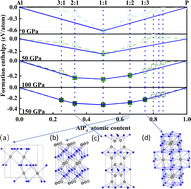Stable multifunctional aluminum phosphides at high pressures†
Abstract
Phosphides have been used in a wide range of applications due to their excellent optical, mechanical, and catalytic properties. Using an effective unbiased structure searching method combined with first-principles calculations, the phase diagram and physical and chemical properties of aluminum phosphides have been determined at high pressures. The results reveal that the unconventional stoichiometries of Al2P, AlP2, and AlP3 remain stable above 66, 91, and 116 GPa, respectively. Interestingly, the analysis of the phonon spectrum suggests that AlP2 with P21 symmetry can be dynamically stable at atmospheric pressure. In addition, the band gap of 1.51 eV at the HSE06 level and the estimated Vickers hardness of ∼10.54 GPa make P21-AlP2 a hard photoelectric material. Moreover, our electronic properties show that AlP3 with Immm symmetry and AlP2 with I4/mmm structure are metallic at high pressures and further electron–phonon coupling calculations indicate Immm-AlP3 and I4/mmm-AlP2 are superconductors with estimated Tc values of 3.9 K at 150 GPa and 10.2 K at 100 GPa, respectively. Our work provides significant inputs toward understanding novel chemical bonding in aluminum phosphides and gives a direction for the experimental synthesis of multifunctional materials at high pressures.



 Please wait while we load your content...
Please wait while we load your content...